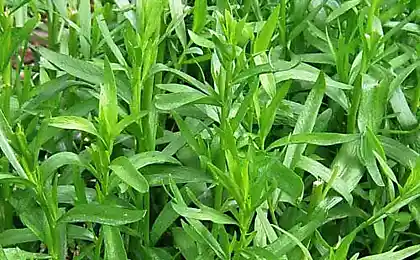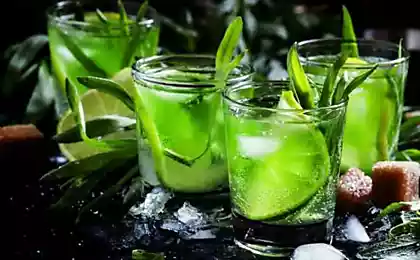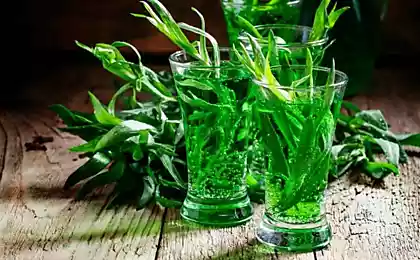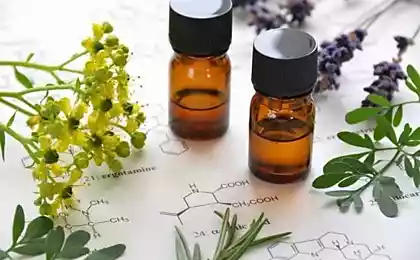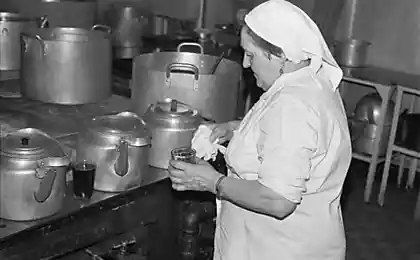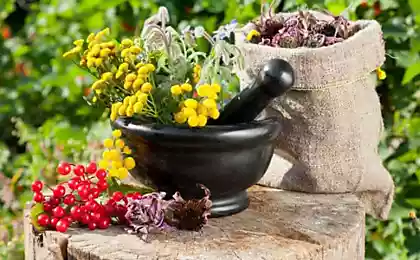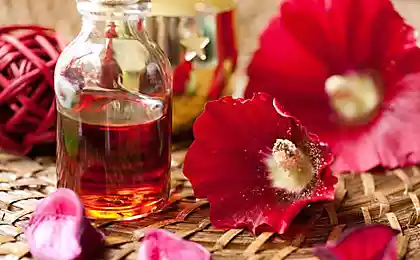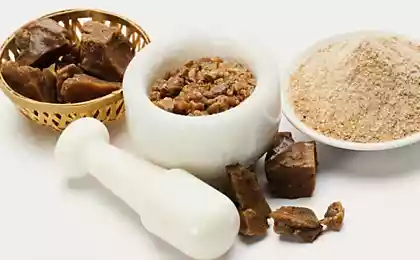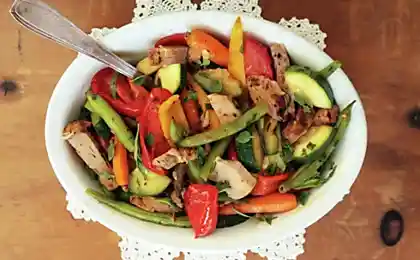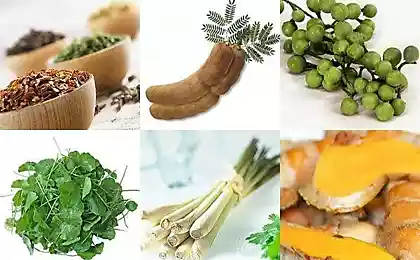393
Tarragon helps with anorexia
Twenty two million nine hundred ninety eight thousand nine hundred fifty four
Fresh green Tarkhun (tarragon), which is also sometimes called the dragon wormwood, popular in cooking, especially in the cuisines of the Mediterranean. This perennial plant is rich in phytonutrients and antioxidants that promote health and prevent diseases. Botany considers tarragon to the Asteraceae family (Asteraceae), genus, sagebrush (Artemisia). Its scientific name — Artemisia dracunculus sativa. It is believed that tarragon is native to Central Asia. Perhaps from Siberia. This plant represents a small tree-like shrub with delicate stems that reach a height of one meter. Tarragon grows well in rich sandy soil with adequate sunlight. It has a smooth dark green long and narrow leaves.
Resource Nutrition And You were considered the most interesting facts concerning the characteristics of the products, its nutritional values and health benefits.
Use tarragon to the health ofThis graceful plant is rich in numerous health beneficial phytonutrients needed to maintain health.
The main essential oils in tarragon are estragole (methylchavicol), cineol, and phellandrene aciman.
Traditionally, tarragon is used as a stimulating the appetite and the means to facilitate anoreksichnyh symptoms.
Scientific studies show that polyphenolic compounds in this plant help to reduce blood sugar levels.
Fresh herbs of tarragon — one of the richest dietary sources of antioxidants among common culinary herbs. His record ORAC (Oxygen radical absorbance capacity), which reflects the ability of antioxidants to absorb oxygen free radicals, is 15542 TE.
Laboratory studies of tarragon extract shows certain compounds in it inhibit platelet activation, preventing platelet aggregation and their adhesion to the walls of blood vessels. This, in turn, helps to prevent the formation of blood clots in the small blood vessels of heart and brain, thus protecting from heart attacks and strokes.
Tarragon is a very rich source of vitamins, including vitamins C and A as well as B-complex — folic and nicotinic acid, Riboflavin and other acting as antioxidants substances, and factors contributing to metabolic enzymes.
Tarragon is an excellent source of minerals such as calcium, manganese, iron, magnesium, copper, potassium and zinc. Manganese is used by the body as a contributing factor in the antioxidant enzyme superoxidedismutase. Iron is essential for cellular (tissue) respiration and is a co-factor of the enzyme cytochromoxidase, and also promotes the formation of red blood cells.
Tarragon in medicine,Tarragon is used in various traditional medicines as appetite stimulant tools and is used in anorexia, dyspepsia (indigestion), flatulence and hiccups.
It contained the essential oil of eugenol used for therapy in dentistry as a local anesthetic and antiseptic for toothache.
Terenowy it is believed to help with insomnia remedy.
The warningContained in the tarragon essential oil estragole may cause some people skin irritation.
Additionally, estragole and its metabolite 1'-hydroxyestradiol can cause in laboratory animals liver tumors, notes resource Nutrition And You. Therefore, to eat the tarragon should be used with caution.
Selecting and storing tarragon
Fresh leaves of tarragon to zasoski harvested in the flowering period. Dry them in moderate sunlight or light heating. Prefer fresh tarragon leaves, whose flavor is more saturated and higher nutritional value. Pick the tarragon leaves from the stalk with a rich aroma. Avoid shrivelled and lost their color long ago lying leaves of tarragon.
At home, wash the tarragon leaves from the stalk under running clean water, dry them with a special paper napkin and store in the refrigerator compartment for vegetables. Use as soon as possible. Dried tarragon is stored in a protected against the penetration of air containers in a cool dark place. Thus dried tarragon can be stored up to six months.
Nutritional value of tarragon (tarragon)
In parentheses are the percentage of the daily allowance. Nutritional value is based on 100 grams of dried herb tarragon (Artemisia dracunculus) according to information from the Ministry of agriculture of the USA, shown in the resource Nutrition And You.
General information:
energy value — 295 kcal (15%);
carbohydrates 50.22 grams (38%);
protein — 22,77 grams (40%);
fats — 7.24 grams (24%);
fiber, part of the food — 7.4 grams (19%).
Vitamins:
folic acid (vitamin B9) — 274 micrograms (68,5%);
nicotinic acid (vitamin B3) — 8,950 milligram (56%);
pyridoxine (vitamin B6) — 2,410 milligrams (185%);
Riboflavin (vitamin B2) — 1,339 milligrams (103%);
thiamine (vitamin B1) 0,251 milligrams (21%);
vitamin a, which very much is contained in dandelion — 4200 international units (IU, IU) is 140%;
vitamin C — 50 milligrams (83%).
Electrolytes:
sodium 62 milligrams (4%);
potassium — 3020 milligrams (64%).
Minerals:
calcium — 1139 mg (114%);
copper — 0,677 milligrams (75%);
iron — milligrams of 32.30 (403%);
magnesium — 347 mg (87%);
manganese — 7,967 milligrams (346%);
zinc — 3.90 milligrams (35%).published
P. S. And remember, just changing your intake, we, together change the world! ©
Source: hi-news.ru
Fresh green Tarkhun (tarragon), which is also sometimes called the dragon wormwood, popular in cooking, especially in the cuisines of the Mediterranean. This perennial plant is rich in phytonutrients and antioxidants that promote health and prevent diseases. Botany considers tarragon to the Asteraceae family (Asteraceae), genus, sagebrush (Artemisia). Its scientific name — Artemisia dracunculus sativa. It is believed that tarragon is native to Central Asia. Perhaps from Siberia. This plant represents a small tree-like shrub with delicate stems that reach a height of one meter. Tarragon grows well in rich sandy soil with adequate sunlight. It has a smooth dark green long and narrow leaves.
Resource Nutrition And You were considered the most interesting facts concerning the characteristics of the products, its nutritional values and health benefits.
Use tarragon to the health ofThis graceful plant is rich in numerous health beneficial phytonutrients needed to maintain health.
The main essential oils in tarragon are estragole (methylchavicol), cineol, and phellandrene aciman.
Traditionally, tarragon is used as a stimulating the appetite and the means to facilitate anoreksichnyh symptoms.
Scientific studies show that polyphenolic compounds in this plant help to reduce blood sugar levels.
Fresh herbs of tarragon — one of the richest dietary sources of antioxidants among common culinary herbs. His record ORAC (Oxygen radical absorbance capacity), which reflects the ability of antioxidants to absorb oxygen free radicals, is 15542 TE.
Laboratory studies of tarragon extract shows certain compounds in it inhibit platelet activation, preventing platelet aggregation and their adhesion to the walls of blood vessels. This, in turn, helps to prevent the formation of blood clots in the small blood vessels of heart and brain, thus protecting from heart attacks and strokes.
Tarragon is a very rich source of vitamins, including vitamins C and A as well as B-complex — folic and nicotinic acid, Riboflavin and other acting as antioxidants substances, and factors contributing to metabolic enzymes.
Tarragon is an excellent source of minerals such as calcium, manganese, iron, magnesium, copper, potassium and zinc. Manganese is used by the body as a contributing factor in the antioxidant enzyme superoxidedismutase. Iron is essential for cellular (tissue) respiration and is a co-factor of the enzyme cytochromoxidase, and also promotes the formation of red blood cells.
Tarragon in medicine,Tarragon is used in various traditional medicines as appetite stimulant tools and is used in anorexia, dyspepsia (indigestion), flatulence and hiccups.
It contained the essential oil of eugenol used for therapy in dentistry as a local anesthetic and antiseptic for toothache.
Terenowy it is believed to help with insomnia remedy.
The warningContained in the tarragon essential oil estragole may cause some people skin irritation.
Additionally, estragole and its metabolite 1'-hydroxyestradiol can cause in laboratory animals liver tumors, notes resource Nutrition And You. Therefore, to eat the tarragon should be used with caution.
Selecting and storing tarragon
Fresh leaves of tarragon to zasoski harvested in the flowering period. Dry them in moderate sunlight or light heating. Prefer fresh tarragon leaves, whose flavor is more saturated and higher nutritional value. Pick the tarragon leaves from the stalk with a rich aroma. Avoid shrivelled and lost their color long ago lying leaves of tarragon.
At home, wash the tarragon leaves from the stalk under running clean water, dry them with a special paper napkin and store in the refrigerator compartment for vegetables. Use as soon as possible. Dried tarragon is stored in a protected against the penetration of air containers in a cool dark place. Thus dried tarragon can be stored up to six months.
Nutritional value of tarragon (tarragon)
In parentheses are the percentage of the daily allowance. Nutritional value is based on 100 grams of dried herb tarragon (Artemisia dracunculus) according to information from the Ministry of agriculture of the USA, shown in the resource Nutrition And You.
General information:
energy value — 295 kcal (15%);
carbohydrates 50.22 grams (38%);
protein — 22,77 grams (40%);
fats — 7.24 grams (24%);
fiber, part of the food — 7.4 grams (19%).
Vitamins:
folic acid (vitamin B9) — 274 micrograms (68,5%);
nicotinic acid (vitamin B3) — 8,950 milligram (56%);
pyridoxine (vitamin B6) — 2,410 milligrams (185%);
Riboflavin (vitamin B2) — 1,339 milligrams (103%);
thiamine (vitamin B1) 0,251 milligrams (21%);
vitamin a, which very much is contained in dandelion — 4200 international units (IU, IU) is 140%;
vitamin C — 50 milligrams (83%).
Electrolytes:
sodium 62 milligrams (4%);
potassium — 3020 milligrams (64%).
Minerals:
calcium — 1139 mg (114%);
copper — 0,677 milligrams (75%);
iron — milligrams of 32.30 (403%);
magnesium — 347 mg (87%);
manganese — 7,967 milligrams (346%);
zinc — 3.90 milligrams (35%).published
P. S. And remember, just changing your intake, we, together change the world! ©
Source: hi-news.ru
In St. Petersburg will be outside of the containers
Success story: Amy Purdy lost everything and did not give up
